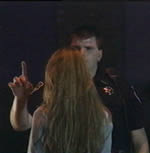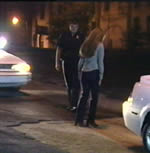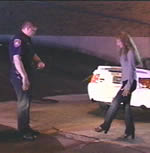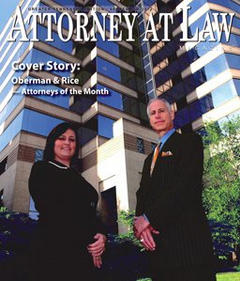Introduction
Although this is intended to be a very cursory summary of field sobriety tests, the attorneys at Oberman & Rice can explain to you in more detail the history of the field sobriety tests, the administrative procedures, the instructions, the standardized clues and the scoring system when you meet with him. In fact, all of our attorneys have received the same training as law enforcement and are certified to administer the National Highway Traffic Safety Administration (NHTSA) Standardized Field Sobriety Tests. Steve Oberman has been certified as an Instructor for the NHTSA DWI Detection and Standardized Field Sobriety Test Administration.
History
Field sobriety tests have been around as long as the enforcement of DUI laws. For years, field sobriety tests varied among officers within the same law enforcement agency as well as from one agency to another. Field sobriety tests were limited only by the officers’ collective imaginations. In the late 1970’s the United States Department of Transportation, National Highway Traffic Safety Administration (hereinafter referred to as NHTSA), funded research to evaluate currently used physical coordination tests which were used to determine the relationship between intoxication and driving impairment, to develop more sensitive tests which would provide a reliable means of identifying persons with a blood alcohol level above the legal limit, and to standardize the tests. The researchers finally concluded that the three test battery, which included the Horizontal Gaze Nystagmus, Walk-and-Turn, and One-Leg Stand, offered a reliable field sobriety testing procedure. The next step was to standardize these tests. Additional research was therefore conducted to complete the development and validation of this sobriety test battery and to assess the battery’s feasibility in the field, as well as its effectiveness for estimating the blood alcohol content of subjects and facilitating the identification of persons with a blood alcohol content above the legal limit.
Types of Field Sobriety Tests
Horizontal Gaze Nystagmus – Nystagmus is the involuntary jerking of the eye. It can be an indication of intoxication. However, the occurrence of nystagmus is not dependent upon the presence of an intoxicant in the body. Substances that would not interfere with driving ability can produce nystagmus, and nystagmus may be congenital or caused by structural neurological disease.
Examples of possible manifestations of alcohol impairment emerging during nystagmus test include the inability to keep the head still; noticeable swaying, and the utterance of incriminating statements. Points are not deducted, however, for any of these behaviors.
Examples of conditions that may interfere with suspect’s performance of the nystagmus test include a suspect having an artificial eye; having damaged or very weak vision in one eye; eye irritants such as wind, dust, and rain; and visual and other distractions which impede the test, such as traffic, blinking lights, rain, etc. Some persons who are not under the influence may exhibit nystagmus.
Nystagmus may also be caused by certain pathological disorders such as brain tumors, brain damage and some diseases of the inner ear.
Walk and Turn – In this test, the subject assumes a heel-to-toe stance with the subject’s arms down at her side. The subject is to maintain this position until the officer tells her to begin walking. At that time, pursuant to the instructions given by the officer during the instruction phase, the subject is to take 9 heel-to-toe steps down a real or imaginary line, turn around and take 9 heel-to-toe steps back up the line. The turn is not a pivot, but instead is made by taking a series of small steps with one foot, keeping the front foot on the line. While walking, the subject is to keep her arms at her side, watch her feet at all times, and count her steps out loud. Examples of conditions that may interfere with suspect’s performance of the walk and turn test include wind and weather conditions; the suspect being over the age of sixty; the footwear of the suspect; and highway traffic.
One Leg Stand – The instructions for this test are given to the subject while the subject stands with her feet together, and arms down at his side until told to start. The instructions which are supposed to be given to the subject (with accompanying demonstration) are for the subject to stand on one leg (either leg), holding out the other foot approximately 6 inches off the ground, foot pointed forward so the raised foot is approximately parallel to the ground. While standing, the subject may be instructed to maintain this position while the officer estimates thirty seconds or the subject may be told to count out loud (one thousand and one, one thousand and two, and so on). Either way, the subject is to keep his arms at his sides at all times and watch the raised foot. Examples of conditions which may impede a suspect’s ability to perform this test include a test surface which is not dry and level; the suspect being over the age of sixty; the suspect being at least fifty pounds overweight; footwear which impedes the performance of the test, such as heels; and certain medical problems and disabilities.
Non-Standardized Field Sobriety Tests
There are other, non-standardized, field sobriety tests which have been approved for use by such organizations as International Association of Chiefs of Police (“I.A.C.P.”) in their “Improved Sobriety Testing for Boating/Alcohol Enforcement” Student Manual and the U.S. National Park Service. These tests include, but are not limited to, the finger to nose test, the finger count test, the hand pat test, the alphabet test, the reverse counting test, and the coin pickup test.
The information detailed above has been summarized from the U.S. Department of Transportation, National Highway Traffic Safety Administration, DWI Detection and Standardized Field Sobriety Testing, Student Manual (2000).
Featured Posts
 March 25, 2025
March 25, 2025
Tennessee Drivers’ Licenses May Go Electronic
Tennessee Senate Bill 1297 was introduced this year proposing to allow Tennesseans to use Digital Driver’s Licenses (DDLs) as a valid form of identification wherever an ID is legally required, except for voting. The DDLs would allow Tennesseans to download an […]
Read More
 February 26, 2025
February 26, 2025
Potential Change in Legislation for Providing Proof of Registration to Law Enforcement
When a driver is pulled over in Tennessee for any reason, the normal request from law enforcement is: “Please provide me with your driver’s license, insurance, and proof of registration.” If you are like this author, digging through your glovebox […]
Read More February 17, 2025
February 17, 2025
Domestic Violence/Domestic Assault/Domestic Abuse Definitions
Domestic Violence/Domestic Assault/Domestic Abuse Definitions We are often asked about the difference between an assault (sometimes referred to as a “simple” assault), and a domestic abuse assault. This is an important distinction in the law because there are different bond […]
Read MoreContact
Office
Oberman & Rice
550 Main Street
Suite 730
Knoxville, TN 37902
Phone Number
(865) 249-7200
(865) 540-1696 (fax)
GPS Coordinates
Long: 35.970504
Lat: -83.914776
Useful Links
contact us today for a free consultation
We reply to non-urgent after-hours requests for consultation within 24 hours. For after-hour emergencies, please call us at (865) 249-7200.


















